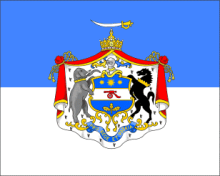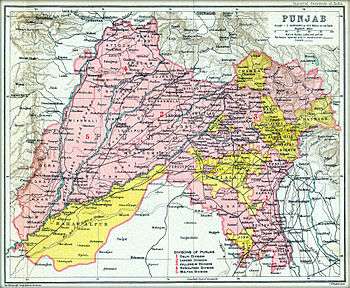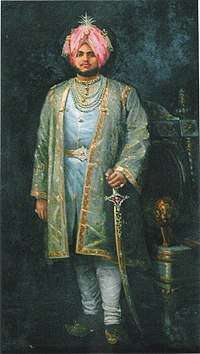Kapurthala State
Kapurthala State, with its capital at Kapurthala, was a former Princely state of Punjab, Ruled by Ahluwalia Sikh rulers, spread across 352 square miles (910 km2). According to the 1901 census the state had a population of 314,341 and contained two towns and 167 villages.[1] In 1930, Kapurthala became part of the Punjab States Agency and acceded to the Union of India in 1947.
| Kapurthala State | |||||||||
|---|---|---|---|---|---|---|---|---|---|
| Princely State of British India | |||||||||
| 1772–1947 | |||||||||
 Flag
 Coat of arms
| |||||||||
 Kapurthala State on a 1909 Punjab map. | |||||||||
| Area | |||||||||
• 1901 | 352 km2 (136 sq mi) | ||||||||
| Population | |||||||||
• 1901 | 314,341 | ||||||||
| Historical era | New Imperialism | ||||||||
• Established | 1772 | ||||||||
• Independence of India | 1947 | ||||||||
| |||||||||
| Today part of | Punjab, India | ||||||||
| Kapurthala state The Imperial Gazetteer of India, 1909, v. 14, p. 408–416. | |||||||||


Origins
The ruling dynasty of Kapurthala originated in the Ahluwalia misl. The dynasty's records trace their ancestry to the Bhatti tribe of Jaisalmer. After 1530 they are called Bhatti, and ultimately, the Hindu deity Krishna. According to this account, Krishna's descendant Gaj built the fort of Gajni, and lost his life in a battle against a joint Roman-Khorasani army. His son Salibahan established the city of Sialkot, and started the Shak era after defeating the Shaks in 78 CE.
After the Muslim conquest of Punjab, his descendants migrated to the Jaisalmer area, where they came to be known as Bhatti tribe. After Alauddin Khalji's conquest of Jaisalmer, some of the Bhatti tribe people's migrated to Tarn Taran district, mingled with Jats. Gradually, they came to be known as Jats, and in the 17th century, they joined Guru Hargobind's army. Ganda Singh of this family raided Lahore, whose governor Dilawar Khan persuaded him to join the Lahore army, and assigned him the fief of Ahlu and some other villages. Ganda Singh's son Sadhu (or Sadho) Singh lived in Ahlu, because of which the family came to be known as Ahluwalia. Sadhu Singh and his four sons married into Kalal families, because of which the family came to be known as Ahluwalia. The descendants of Sadhu Singh son Gopal Singh (who was the grandfather of Jassa Singh) established the royal family of Kapurthala.[2] The British administrator Lepel Griffin (1873) dismissed this account as spurious.[2] The Sikh author Gian Singh, in his Twarikh Raj Khalsa (1894), wrote that the Ahluwalia family adopted the Kalal caste identity much before Sadhu Singh.[3]
The Ahluwalia misl rose to prominence under Jassa Singh Ahluwalia,[4][5] who was the first person to use the name "Ahluwalia". Originally known as Jassa Singh Kalal, he styled himself as Ahluwalia after his ancestral village of Ahlu.[6] He is regarded as the founder of the Kapurthala State.[7]
Even after other misls lost their territories to Ranjit Singh's Sikh Empire, the emperor permitted the descendants of Jassa Singh to retain their estates. After the British took over the Sikh territories in 1846, Jassa Singh's descendants became the ruling family of the Kapurthala State.[8]
Royal family
Sardars
- Jassa Singh (1777 – 20 October 1783)[9] (b. 1718 – d. 1783)[10]
- Bagh Singh (20 October 1783 – 10 July 1801) (b. 1747 – d. 1801)
Rajas
- Fateh Singh (10 July 1801 – 20 October 1837) (b. 1784 – d. 1837)
- Nihal Singh (20 October 1837 – 13 September 1852) (b. 1817 – d. 1852)
- Randhir Singh (13 September 1852 – 12 March 1861) (b. 1831 – d. 1870)[10]
Raja-i Rajgan
- Randhir Singh (12 March 1861 – 2 April 1870) (b. 1831 – d. 1870)
- Kharak Singh (2 April 1870 – 3 September 1877) (b. 1850 – d. 1877)
- Jagatjit Singh (3 September 1877 – 12 December 1911) (b. 1872 – d. 1949)[10]
Maharajas
- Jagatjit Singh (12 December 1911 – 15 August 1947) (b. 1872 – d. 1949)[10]
- Paramjit Singh
- Brigadier Sukhjit Singh MVC
References
- Kapurthala state The Imperial Gazetteer of India, 1909, v. 14, p. 408.
- Ganda Singh (1990). Sardar Jassa Singh Ahluwalia. Punjabi University. pp. 1–4.
- M. L. Ahluwalia (1996). Land marks in Sikh history. Ashoka International. p. 37.
- Kaushik Roy (2015). Military Manpower, Armies and Warfare in South Asia. Routledge. p. 88. ISBN 9781317321279.
- Singhia, H.S. (2009). The encyclopedia of Sikhism. New Delhi: Hemkunt Press. p. 111. ISBN 978-81-7010-301-1.
- Donald Anthony Low (1968). Soundings in Modern South Asian History. University of California Press. pp. 70–71. OCLC 612533097.
- Sohan Singh Seetal (1981). The Sikh Misals and the Punjab States. Lahore Book Shop. p. 75.
- W. H. McLeod (2009). The A to Z of Sikhism. Scarecrow Press. p. 6. ISBN 978-0-8108-6344-6.
- Kapurthala
- "KAPURTHALA". Royal Family of India. 12 April 2013. Retrieved 9 January 2018.
External links

- Kapurthala www.sikh-heritage.co.uk
